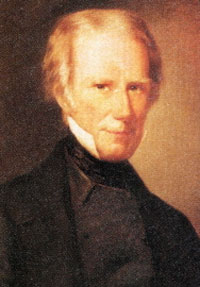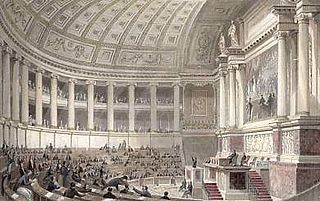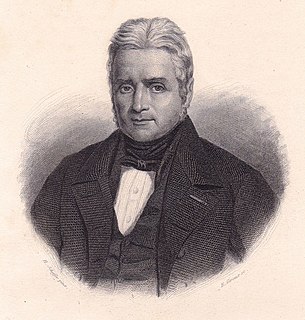
The Fourteenth United States Congress was a meeting of the legislative branch of the United States federal government, consisting of the United States Senate and the United States House of Representatives. It met in the Old Brick Capitol in Washington, D.C. from March 4, 1815, to March 4, 1817, during the seventh and eighth years of James Madison's presidency. The apportionment of seats in the House of Representatives was based on the Third Census of the United States in 1810. Both chambers had a Democratic-Republican majority.

The Fifteenth United States Congress was a meeting of the legislative branch of the United States federal government, consisting of the United States Senate and the United States House of Representatives. It met in the Old Brick Capitol in Washington, D.C. from March 4, 1817, to March 4, 1819, during the first two years of James Monroe's presidency. The apportionment of seats in the House of Representatives was based on the Third Census of the United States in 1810. Both chambers had a Democratic-Republican majority.
The three classes of United States Senators are made up of 33 or 34 Senate seats each. The purpose of the classes is to determine which Senate seats will be up for election in a given year. The three groups are staggered so that senators in one of the groups are up for election every two years, rather than having all 100 seats up for election at once. For example, the 33 Senate seats of class 1 were up for election in 2018, the elections for the 33 seats of class 2 will take place in 2020, and the elections for the 34 seats of class 3 will be held in 2022.

Elections to the United States House of Representatives for the 15th Congress were held in the various states between April 1816 and August 14, 1817. The Congress first met on December 1, 1817.

The 1818 United Kingdom general election saw the Whigs gain a few seats, but the Tories under the Earl of Liverpool retained a majority of around 90 seats. The Whigs were divided over their response to growing social unrest and the introduction of the Corn Laws.
Bernhart Henn was a pioneer lawyer and businessman, and a two-term Democratic U.S. Representative from Iowa's 1st congressional district during Iowa's first decade of statehood.

The 10th constituency of the Yvelines is a French legislative constituency in the Yvelines département.
The United States Senate elections of 1816 and 1817 were elections for the United States Senate that had the Democratic-Republican Party gain a net of two seats from the admission of a new state, and which coincided with the presidential election.
The 1816 United States House of Representatives elections in New York were held from April 23 to 25, 1816, to elect 27 U.S. Representatives to represent the State of New York in the United States House of Representatives of the 15th United States Congress. At the same time, a vacancy was filled in the 14th United States Congress.
The 1818 United States House of Representatives elections in New York were held from April 28 to 30, 1818, to elect 27 U.S. Representatives to represent the State of New York in the United States House of Representatives of the 16th United States Congress.

The 41st New York State Legislature, consisting of the New York State Senate and the New York State Assembly, met from January 27 to April 21, 1818, during the first year of DeWitt Clinton's governorship, in Albany.
The 1816 special elections for Maryland's 5th congressional district were to fill two separate vacancies. The 5th district was a plural district, with two seats. Both seats were vacated, the first by Representative Nicholas R. Moore (DR) in 1815, before the 14th Congress even met, and the second by Rep. William Pinkney (DR) on April 18, 1816 after being named Minister to Russia.
On April 16, 1816, Richard Stanford (DR) of North Carolina's 8th district died in office. A special election was held to fill the resulting vacancy
A special election was held in Connecticut's at-large district in 1817 to fill two vacancies in the 15th Congress, both of which had occurred before the start of that Congress. The vacancies were left by the death of members-elect Sylvanus Backus (F) on February 15, 1817 and Charles Dennison (F) who declined the seat.
In 1818, Uriel Holmes (F) of Connecticut's at-large district resigned from the House. A special election was held to fill the resulting vacancy.
On November 7, 1818, a special election was held in North Carolina's 11th district to fill a vacancy caused by Daniel M. Forney (DR)'s resignation earlier that year.
Elections to the House of Representatives in Missouri for the 23rd Congress were held August 5, 1832 and August 6, 1833 for two Representatives. Unusually, rather than a single election for both seats, the second seat was elected a year after the first.
A special election was held August 26, 1817 in Massachusetts's 1st congressional district to fill a vacancy left by the resignation of Representative-elect James Lloyd (F) before the beginning of the 15th Congress.

The 1819 French partial election took place on 11 September 1819, during the Second Restoration, to choose delegates to the French Chamber of Deputies. It was the third of three elections under a new law that called for legislative elections to be held annually in one-fifth of the nation's departments.

The 1816 United States elections elected the members of the 15th United States Congress. Mississippi and Illinois were admitted as states during the 15th Congress. The election took place during the First Party System. The Democratic-Republican Party controlled the Presidency and both houses of Congress, while the Federalist Party provided only limited opposition. The election marked the start of the Era of Good Feelings, as the Federalist Party became nearly irrelevant in national politics after the War of 1812 and the Hartford Convention.










